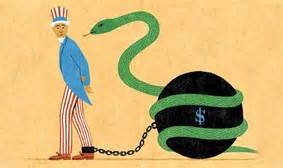CBO Issues New Debt Projections & Warnings
Thursday, April 24th, 2014 @ 9:50PM
Between the Lines
by Gary D. Halbert
The non-partisan Congressional Budget Office recently issued new budget deficit and national debt projections for the next 10 years. The results show an unprecedented national debt in the coming decade.
The CBO’s new budget projections contain an eerie warning that we are on path from today’s already unfathomable $17.7 trillion in federal government debt to more than $27 trillion in 2024. And in all likelihood, even this startling estimate may be too low.
Why? Because the CBO estimated that federal tax revenues over the next decade will be higher than the 40-year average as a share of GDP. If tax revenues, as a percentage of GDP, hold steady or decline over the next 10 years, then the CBO’s latest debt projections are too low.
The CBO says the national debt will reach 78% of GDP by 2024, which is double the 39% average of the past 40 years. This figure is very misleading, as I have pointed out for many years. The reason is that our national debt of $17.7 trillion is already more than 100% of GDP!
Let me explain. At the end of 2013, the Commerce Department reported that total Gross Domestic Product – the sum of all goods and services produced in the economy – was $17.1 trillion. At $17.7 trillion, our national debt is now over 103% of GDP.
So why does the CBO say our debt will be only 78% of GDP by 2024? That’s because the CBO only counts “debt held by the public” in its debt-to-GDP ratio. According to the Fed, US debt held by the public was $12.4 trillion at the end of last year. The other $5.3 trillion is owned by various governmental agencies.
The CBO has long argued that it should not include this debt owned by the government in its debt-to-GDP ratio calculations. I have argued for years that this debt owned by governmental agencies should be included in such ratios. After all, this debt owned by the government matures just like all other debt and must be rolled over periodically with new instruments.
So despite what the CBO says, the current US debt-to-GDP ratio is now over 100% of GDP.
The CBO warned that if our national debt soars to $27 trillion over the next decade, the consequences will include “big hikes in spending on interest payments on the debt when interest rates go back up.”
That, in turn, would increase the cost of investment and “the capital stock would be smaller, and productivity and wages lower, than if federal borrowing was more limited,” the CBO warned.
The CBO also cautioned that such a massive increase in the debt would result in “less flexibility [for future Congresses] to use tax and spending policies to respond to unexpected challenges.” Most chillingly, the CBO warned that increasing the national debt to $27 trillion by 2014 “increases the risk of a fiscal crisis in which investors would lose so much confidence in the government’s ability to manage its budget that the government would be unable to borrow at affordable rates.” No kidding!
The CBO baseline assumes political paralysis on entitlement spending over the next decade. Put differently, the CBO assumes that there will be no meaningful entitlement reform over the next decade. And apparently, the CBO doesn’t think it makes much difference which political party is in control of the government. That is so sad, but it just might be true!
House Budget Committee Chairman Paul Ryan recently released a new 10-year budget plan that cuts $5 trillion in federal spending and balances the budget by 2024. It revamps and saves Medicare for future generations who could choose from a list of guaranteed-coverage health plans based on need. And his plan would jump-start the economy with tax reform aimed at generating jobs and moving away from class warfare.
Rep. Ryan was savaged in the media!
Finally, if you had asked me 10 years ago if I thought the government could still function with over $17 trillion in debt, I would have answered absolutely not. I would have argued that the bond market would collapse. Yet interest rates have steadily gone down over that same period, even though the national debt has more than doubled.
Can the government and the bond market keep it all together if we add another $10 trillion to the debt over the next decade? I wouldn’t bet on it!
Posted by AIA Research & Editorial Staff
Categories: Between the Lines



